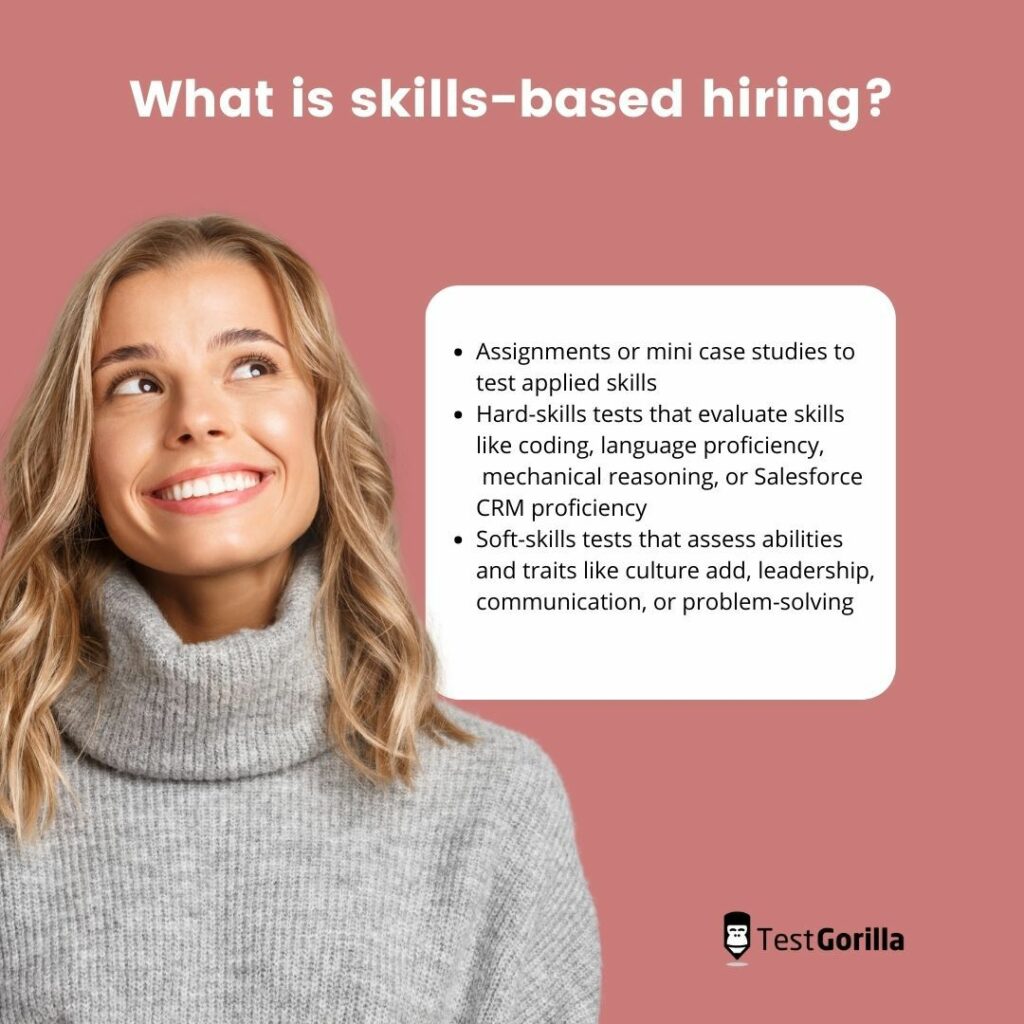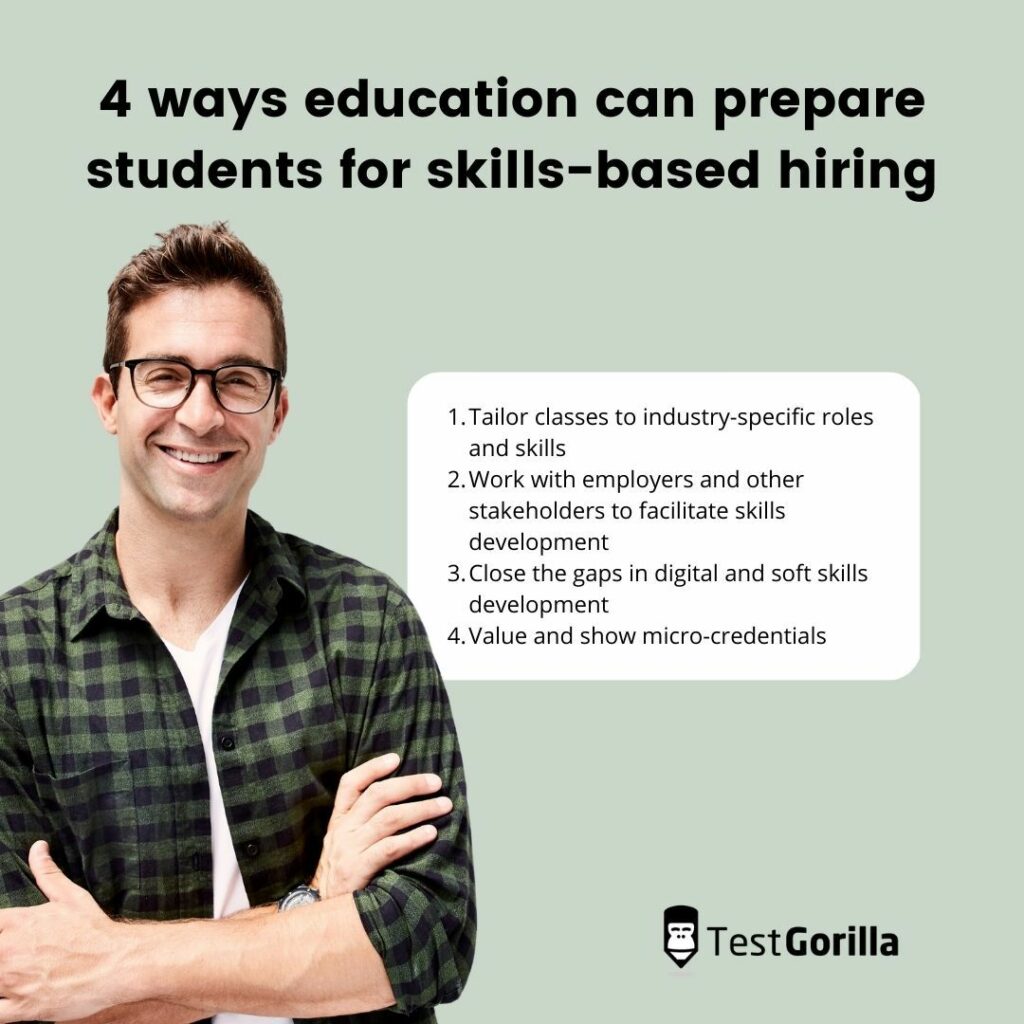So you’re a hiring manager for a scaling company. Your hiring process has recently changed, and you no longer require degrees for every open position.
But, like most HR professionals, you’re used to valuing educational achievements and the names of distinguished institutions on candidates’ resumes, even if this is an outdated way to predict their success.
However, now that you’re no longer assessing candidates based on these factors, what’s the best way to evaluate them?
One solution to accurately sizing up your candidates, regardless of education, is to adopt a skills-based approach to hiring.
This levels the playing field for candidates of all backgrounds by identifying and rewarding the right people based on their expertise and skills – not what or where they studied. This lets you enhance the quality of your hires and better align candidates to the skill requirements of your open positions and company culture.
In this guide, we’ll walk you through the following:
Table of contents
What is skills-based hiring?
Skills-based hiring is an emerging, more equitable approach to hiring that helps you assess a candidate’s skill set in the early stages of the application process. It lets you determine their value-add to your company through scientifically backed skills assessments and assignments that replicate on-the-job scenarios.
Unlike relying on resumes or potentially biased algorithms in applicant tracking systems, skills-based hiring focuses on hiring the best people for the position based on their skills and applied expertise.
Types of skills-based hiring include:
Assignments or mini case studies to test applied skills
Hard-skills tests that evaluate skills like coding, language proficiency, mechanical reasoning, or Salesforce CRM proficiency
Soft-skills tests that assess abilities and traits like culture add, leadership, communication, or problem-solving
According to our 2022 State of Skills-Based Hiring report, 92.5% of companies saw a reduction in mis-hires using skills-based hiring methods. This is no small impact, considering that a mis-hire costs 24 times an employee’s annual salary. And 72.1% of employees who were hired using skills-based testing reported being happy in their roles.
By using a skills-based approach to hiring, you can find candidates who are more likely to succeed regardless of their education, resume, work experience, or connections.
Skills-based hiring also helps candidates understand the requirements of the position beforehand to better gauge whether it’s right for them. All of this saves you the stress and financial strain of high employee turnover.
Why are skills gaining importance in hiring?
Catalyzed by the Covid-19 pandemic and the growing automation of certain roles, many companies are moving away from traditional hiring methods that favor education and resumes – resulting in degree inflation and bias – in favor of skills-based hiring.
The increase in demand for high-growth professionals is driving a range of distinctive skill sets, such as:
Business skills like marketing, project management, and business development
Specialized industry-specific skills like video editing in marketing or documentation in cloud computing
General and soft skills like leadership, communication, and creativity
Baseline tech skills like basic computer literacy and web design
Disruptive tech skills like data science, natural language processing, and robotics
Since the demand for these skills exceeds the current supply, employers are more likely to de-emphasize degrees. Instead, they focus on the skills that more accurately predict candidate success within the company or position, especially considering only 4 in 10 people aged 25 and older have a bachelor’s degree in the US.
And although skills-based hiring is mostly applied in remote and hybrid companies and the tech sector, [56% of employers](https://www.shrm.org/about-shrm/press-room/press-releases/pages/new-shrm-research-makes-the-case-for-skills-based-hiring.aspx#:~:text=%E2%80%94%20SHRM%20(the%20Society%20for%20Human,'%20knowledge%2C%20skills%20and%20abilities.) now use pre-assessment tests to better determine candidates’ abilities, skills, and knowledge.
Traditionally, employers value degrees and work history, but as the world has grown and changed, skills-based hiring has become an important part of finding the right candidate for a given position. This method of hiring recognizes that not all candidates can have the same level of education or work experience and instead focuses on the specific skills and abilities that each candidate brings to the table.
Darren Shafae, the founder of ResumeBlaze[1]
Skills development in education
Until recently, educational institutions have been slow to adapt and prepare students for a labor market focused on skills and individual capabilities.
Instead, they focus on academic disciplines and form curriculums based on distinct subject matter – which isn’t always relevant to current (or future) market demands in skills or experience.
Because of the historical lack of skills development and training in education, we’ve seen drastic shortages in skilled talent, gaps in opportunity in the labor market, and rising unemployment among graduates.
The current situation
In our 2022 State of Skills-Based Hiring report, we found employers favor hiring teenage employees for low-skilled jobs and younger millennials for middle-skilled jobs. This forces Gen Z graduates to find work in areas that don’t align with their skills or career objectives.
To make things worse, Gen Z graduates struggle to differentiate themselves and their skills on job applications. Our survey found that 56% of Gen Z respondents felt their lack of experience prevented them from landing a job opportunity.
And since fewer students are pursuing higher education, educational institutions need to emphasize skills-based learning and develop future-proof graduates to stay relevant and in business.
The shift to skills-based education
The rising tension between developing students’ hard and soft skills while maintaining theoretical coursework has led many educational institutions to re-examine their curricula.
For example, universities across the European Union are equipping students with digital and green skills by creating syllabi entirely focused on skills development. Based on their initiatives, they aim to have 80% of people trained in basic digital skills and 20 million information and communications technology specialists employed by 2030.
Skills-development programs and certifications have also taken off throughout UK-based universities with a recent £490 million skills training boost to get more graduates into skills-based jobs.
There’s a growing effort among educational institutions to equip people with the hard and soft skills they need in a changing world. Many universities and colleges are now focusing on teaching practical skills that can be applied in the workplace, such as communication, teamwork, leadership, critical thinking, and problem-solving abilities. These skills are becoming increasingly important for success in today’s economy, and educational institutions are starting to recognize this by offering more opportunities for students to develop these critical skills. Darren Shafae, the founder of ResumeBlaze
Meanwhile, people are also taking upskilling into their own hands through alternative training routes like online learning, trade schools, and skills-based certification programs. With skills-based hiring, skilled by alternative routes (STAR) workers can bypass traditional forms of higher education and land jobs based entirely on their skills.
4 ways education can prepare students for skills-based hiring
Here are some ideas for educational institutions to help drive the change to skills-based education and hiring.
1. Tailor classes to industry-specific roles and skills
According to a study by LinkedIn, skills have changed by 25% on average globally since 2015.[2] To keep up with shifting demands in employability and coveted skills, universities should use data-backed research on skills-based trends and hiring importance when designing courses.
That way, they can tailor syllabi to help develop the relevant skills or industry-specific experience graduates need to succeed. This can be done through practical, hands-on approaches to learning, like:
Incorporating project-based or experiential learning opportunities
Providing students with access to online resources (e.g., webinars, ebooks, tutorials)
Implementing internships or apprenticeship programs
Many courses still focus on theoretical learning rather than teaching students the key skills required by businesses. Whilst change hasn’t happened quickly, some universities have adapted and have made changes to course content or now offer industry experience alongside more formal study arrangements.
Natasha Maddock, the co-founder & non-exec director at Events Made Simple[3]
2. Work with employers and other stakeholders to facilitate skills development
Educational institutions need to collaborate with employers and other stakeholders to better understand the requirements of the current job market. This is crucial since fewer than one in three employees are confident their skills will be relevant in five years.
By establishing partnerships with employers and businesses in their area or desired industry, educators can glean valuable insights into what skills their students need to succeed. Then they can use this information to inform their curriculum or training programs.
And employers benefit by gaining access to more diverse candidate pools and forming relationships with interns or interested graduates they can later recruit.
3. Close the gaps in digital and soft skills development
Raghav Gupta, Coursera’s managing director for India and APAC, discussed hard and soft skills at a Times Higher Education summit session:
“We found that in 2019, a lot of the learning was actually happening around technology skills, and it was happening around data skills, and it was happening around business skills.
“What happened in 2020 was that human skills came into the limelight as well. How do we communicate with each other? How do you manage mental health? How do you manage stress? A lot of those skills came up.”
Like employers and organizations around the world, educational institutions need to focus on hard and soft skills development. LinkedIn predicts we’re likely to see three new skills in the top skills for a job between 2023 and 2025 – which could range from hard to soft skills.
Educational institutions need to prioritize:
Providing students with the necessary tools and resources, like webinars and online courses
Striking a balance between hard and soft skills by evaluating courses and the core skills they develop
Basing hard and soft skills development on relevant degrees or industries
4. Value and show micro-credentials
Employers’ needs go way beyond academic qualifications. So they typically struggle to see the core skills or value-add shown by academic courses or qualifications.
To make things easier for employers and graduates, educational institutions could use tools like a skills-based digital badge or QR code that directly relates to the skills acquired by passing students. These badges could live in a kind of “digital passport” or resume that documents a candidate’s acquired skills or postgraduate skills to build on.
Then, faculty could review the badges or skills developed in every course and adjust their learning content based on industry-relevant credentials.
Skills-based education: The way to support future-ready graduates
Traditional, unfair hiring methods like referrals and resumes won’t help you land the best talent. Relying on candidate qualifications instead of skills to determine an applicant’s fit might look good on paper but doesn’t ensure company-candidate alignment. And educational institutions are starting to realize this.
Organizations also want employees who will stay with them and add real value. With this in mind, skills-based hiring is growing in popularity because it ensures each candidate is a culture add or adds value through the skills they bring to the organization.
Testing candidates’ hard and soft skills in ways that mirror on-the-job scenarios means a person’s employability isn’t limited by their race, gender, alma mater, or physical ability.
When new hires are well aligned with their roles and the company culture, they’re more likely to stick around. And that improves ROI for your hiring processes and makes for happier, more productive employees.
The world of work has changed, so employers and educational institutions need to work together to ensure students have the skills they need for future employment. Otherwise, higher education will suffer in light of the shift to skills-based hiring, decreased emphasis on formal qualifications, and growth in people opting to acquire skills by alternative routes.
Some ways to do this include:
Tailor classes to industry-specific roles and skills
Work with employers and other stakeholders to facilitate skills development
Close the gaps in digital and soft skills development
Value and show micro-credentials
When the playing field is leveled in a professional setting, educational institutions will have no choice but to keep up. And that’s a good thing for everyone.
Want to turn skills-based hiring trends to your advantage?
Learn how to test for hard, soft, and transferable skills to make your hiring processes more efficient and effective.
Download the State of Skills-Based Hiring report to find out how.
Sources
“ResumeBlaze | Resume Builder”. ResumeBlaze. Retrieved January 14, 2023. https://www.resumeblaze.com/
“Future of Skills”. LinkedIn. Retrieved January 14, 2023. https://linkedin.github.io/future-of-skills/
“About GBG”. GBG. Retrieved January 14, 2023. https://www.gbgplc.com/en/about-us/
Related posts
Hire the best candidates with TestGorilla
Create pre-employment assessments in minutes to screen candidates, save time, and hire the best talent.
Latest posts
The best advice in pre-employment testing, in your inbox.
No spam. Unsubscribe at any time.

Hire the best. No bias. No stress.
Our screening tests identify the best candidates and make your hiring decisions faster, easier, and bias-free.
Free resources
This checklist covers key features you should look for when choosing a skills testing platform
This resource will help you develop an onboarding checklist for new hires.
How to assess your candidates' attention to detail.
Learn how to get human resources certified through HRCI or SHRM.
Learn how you can improve the level of talent at your company.
Learn how CapitalT reduced hiring bias with online skills assessments.
Learn how to make the resume process more efficient and more effective.
Improve your hiring strategy with these 7 critical recruitment metrics.
Learn how Sukhi decreased time spent reviewing resumes by 83%!
Hire more efficiently with these hacks that 99% of recruiters aren't using.
Make a business case for diversity and inclusion initiatives with this data.





















